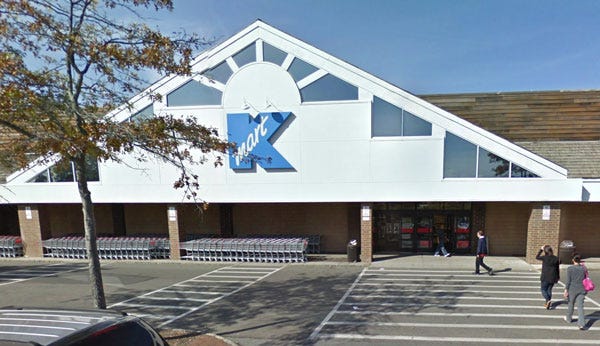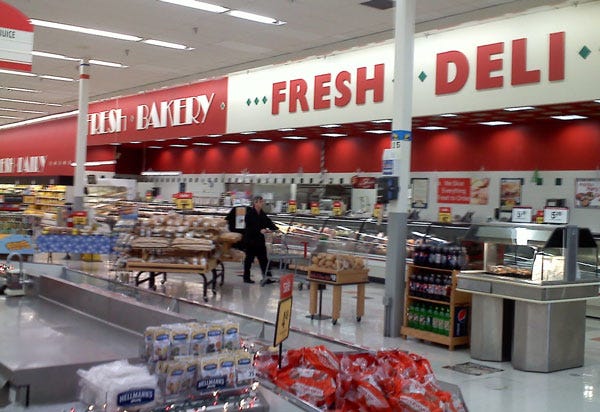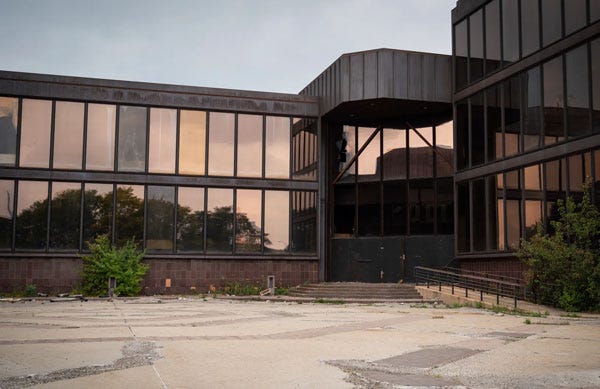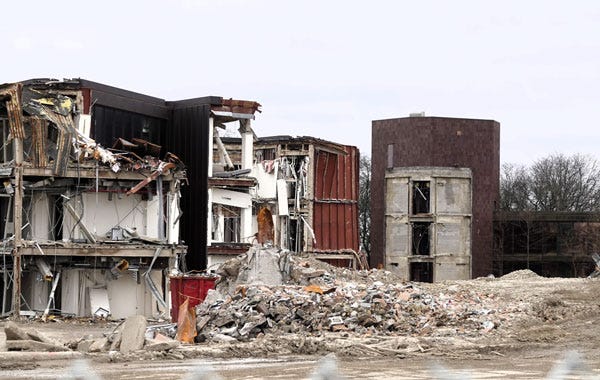Wednesday Walk: Picassos for the Bosses
A look inside Kmart's former HQ, the last Kmart closes, and working the front lines
Welcome to Willoughby Hills!
Every Wednesday, I offer a few short ideas that I hope will inspire you to do some more reading, thinking, and exploring. Let’s take a little walk together and see where the path leads…
Podcast Delay
Our family seems to be caught up in the height of virus season right now. My son was home sick for a bit with a bad cold, which he then promptly gave to me. I have been fighting it off for the last week or so.
I’m on the mend, but not quite back to myself. This is the usual week for my podcast, but this week’s episode will likely be delayed until Friday or Saturday. I still don’t quite have my voice back, or at least not enough where I feel like I could speak well for 45 minutes.
I cross-posted an episode last week, but if you haven’t heard it yet, go listen to the latest Abolition, Liberation, Solidarity episode where
interviews Indigenous Australian Joe Williams. Joe shares some amazing insights about what it takes to reclaim our humanity in this moment, especially as capitalism and other oppressive systems tries to strip away the very meaning of life. Go listen!The Kmart Pyramid Collapses

Perhaps you heard the news that on Sunday, the last full-size Kmart in the country closed its doors permanently. The store had been a feature (perhaps not quite a fixture) in the Long Island community of Bridgehampton for decades. Yes, the final full size Kmart, that blue collar big box, once famous for Blue Light Specials, was in The Hamptons, one of America’s most exclusive enclaves. Although, as I’ll get to in a moment, maybe there has always been a duality to Kmart.
After visiting the last Sears in New England back in 2023 and being wholly unimpressed by what was on offer, I was both curious and completely disinterested by this final Kmart store. (Kmart purchased Sears in 2004, so even though their histories diverge, their futures are eerily parallel).
I didn’t make it down to Long Island in time, and now it’s gone, set to be replaced by a Target store. Or at least, news reports claim it’s gone, and Redditors show the sign being removed. But strangely, the Kmart website still lists the store’s address and opening times (9am-9pm, 7 days a week).
With the closing of Bridgehampton, the only Kmart left in the continental U.S. is in Miami (stores remain in Guam and the U.S. Virgin Islands). The one in Miami was also a full size location originally, but a renovation in 2023 consolidated the entire store into the former garden center space, with the remainder being occupied by an At Home store. This downsizing of store footprints became common under Sears too.

It wasn’t that long ago that Kmart was a real juggernaut, with more than 2,000 stores across the country.
I remember when the first Super Kmart Center opened near us in Mentor, Ohio in 1994. We had yet to see a Target in our area and still had the smaller format Wal-Mart stores, so when this Super Kmart opened, we weren’t quite sure what to make of it.
The store was like a regular Kmart enlarged by a good bit, plus with an entire full service grocery store added to it (similar to a Wal-Mart Supercenter or a Super Target). At more than 195,000 square feet, it was a sight to behold, especially as a young kid!

Kmart’s ad campaigns in the 1990s featured Penny Marshall and Rosie O’Donnell, the latter during the height of her career as a syndicated talk show host. Martha Stewart signed a licensing deal with the store in 1997, which lasted until 2009.
Kmart featured prominently in
’s film Bowling for Columbine, as the bullets used in the rifles to murder and injure students at Columbine High School were from Kmart. In the film, Moore brought two Columbine survivors to the Kmart corporate headquarters to demand change to their in-store gun policies. And that brings me to what I want to discuss in more detail today- the headquarters.For most of us, our memories of Kmart are at the store level. There are still plenty of renovated Kmarts in use as other businesses, and there are still a handful of abandoned stores which dot the landscape, looking unchanged from the time they closed up shop.
But as the chain continues to implode, I thought it was worth exploring the impact Kmart’s headquarters in Troy, Michigan had and what it tells us about capitalism more broadly.

The corporate campus was often referred to as “Fort Kresge” both to honor Kmart founder Sebastian Spering Kresge and because the building somewhat resembled a fort. The black steel and mirrored glass series of buildings was home to the business from 1972 until 2005.
Here’s some of the design justification for such an eye-catching structure, as quoted in the Detroit Free Press:
"‘The cheapest building would have been a big low rectangle. Cheap and ugly,’ the headquarters' designer, architect Charles Harris, said at the time. ‘We elected to do something different — a unitized building with flexibility. The company is growing fast, and they never know how much additional space they will need.’"
Big low rectangles? How cheap. How ugly. How… basically what every Kmart store is.
But anyways, here’s how Pro Publica described the space:
“In its heyday, Fort Kresge teemed with 5,000 employees and was filled with works of art, including a rare tapestry by Pablo Picasso and a 15th-century Ming Dynasty watercolor on silk.”
Yes, a Picasso and 400 year old silk painting… in a Kmart!

One more little quote about the Kmart headquarters and the amenities offered to corporate employees (again from the Detroit Free Press):
“Former employees fondly recall other unique features to the building.
One was a Sample Sales store that was located in the basement and only open to employees during lunch hour. It sold vendor samples of wide-ranging Kmart merchandise at cut-rate prices, from electronics and toys to exercise equipment and more…
There also was a widely used company cafeteria that served breakfast, lunch and dinner. Another former employee recalls how the cafeteria's batter-dipped fish day was especially popular with colleagues in his department.”
Again, this is Kmart, the discount retailer. Kmart, the company that was known for no frills stores and rock bottom prices. My guess is that the employees at the store level, the ones actually stocking the shelves and handling the cash coming in (and as I’ve written about before, it was all cash back then), were not treated in the same manner.
It’s doubtful that store level employees were given access to sample sales. Their cafeteria was the Kmart Cafe which served hot dogs, and later, Little Caesar’s Pizza, not batter-dipped fish. I can guarantee there was no rare art at the store level. From my experience with retail stores, I’m guessing the break room tables and chairs weren’t even comfortable.
This phenomenon is not unique to Kmart by any means. As companies get bigger, more and more “value” (I use quotation marks, most CEOs would not) gets funneled higher and higher into more and more places.
The fancy lunches and expensive art work at the corporate headquarters only happen because the stock worker and cashier are pulling minimum wage, despite having the most hands-on interaction with the literal money making part of the business.
I can imagine my friends in marketing, merchandising, payroll, or human resources shaking their heads at this assessment. Kmart (and other giant retailers) can only become as big as they are because they put smart systems in place. Because they have folks pitching the Martha Stewarts and Rosie O’Donnells of the world. There’s probably some truth to that.
I think what rubs me the wrong way is the notion that retail jobs (or any service level jobs) should be considered “low skilled” and only paid minimum wage, when the entire pyramid literally rests atop the back of those workers.
It’s also a perfect illustration of why it’s so important to shop locally and support local businesses. I’ve always heard the statistic that when you shop in a big box store, 14% of your purchase stays in the community, but when you shop in a local store, that figure jumps to 48%. But I never really gave it much thought until now.
It’s easy to understand that a local business is going to pay local wages for nearly every step in the process, while a big box store is going to export many of those wages to the people sitting above the store level- everyone from layers of management like district managers to corporate roles like marketing and finance to all the various chiefs (CEO, CFO, COO, CMO, CCO, etc).
In the case of Kmart, that was clear to see. Again, my local Super Kmart Center in Mentor, Ohio was impressive when it opened, but it wasn’t 15th century Ming Dynasty watercolor cool!

Perhaps it’s fitting that the only Mainland U.S. presence of Kmart boils down to a few folks working an entire store out of what was once the garden department in Miami. The corporate offices are finally demolished after sitting vacant for nearly two decades. The former Fort Kresge is set to be replaced by a lifestyle center, with construction starting in 2025.

Shifting Shifts
One way to increase understanding between store level operations and the corporate office is to simply have more executives and white collar workers spend some time as front line workers.
Home Depot announced earlier this month that starting next quarter, they will be requiring corporate employees to work at least one eight hour shift per quarter in a retail store.
“For white-collar workers, this move serves as an opportunity to gain firsthand insight into customer interactions, operational challenges and the physical demands of retail work, potentially enhancing their managerial and strategic decisions.”
I have been very critical of in-person mandates of white collar workers, especially for roles that can easily be done remotely. I don’t think it’s worth the environmental or personal cost for people whose primary job functions can be completed online to be forced on site. However, this mandate of requiring in-store work is a good one.
There’s really no better way to understand a business than to see it at the so called ground level. Executives and middle managers can often get so stuck in their own job roles that they forget how clients approach their businesses or where the money is actually made.
This idea is also why I used to find the CBS reality show Undercover Boss so compelling. It’s rare for CEOs to truly understand the day to day realities of frontline workers, and the show facilitated just that kind of discovery. (For those unfamiliar, the show follows a CEO in disguise as they work frontline roles in their company, under the premise that a different reality show is being filmed).
It’s also perhaps why there’s such a visceral reaction (both good and bad) to seeing Donald Trump don an apron and work behind the counter of a McDonald’s earlier this week.

While meant to feel like an organic moment, the 30 minute shift was carefully staged. The restaurant was closed in advance, drive thru customers were selected and screened, and Trump did very little real work. Some of the interactions are especially cringey, feeling like something out of some weird combination of The Office and propagandist TV (like when two drive thru customers say they “pray for” Trump).
(Unrelated, but McDonald’s is also in the news this week for an E. coli outbreak that has killed one person and sickened at least 49.)
Hopefully executives at companies large and small will begin taking a page from the Home Depot playbook and have some deep, meaningful interactions at the store level. Kmart didn’t die solely because they had Picassos hanging in Troy, Michigan, but I can’t help but wonder if that disparity between store level and management factored in to the overall culture in a way that did some damage.
I publish new issues every Wednesday and Sunday. Sign up to always receive the latest issue and support my work:
Other Wednesday Walks
If you’ve missed past issues of this newsletter, they are available to read here.






A recent visit to Bentonville, AR revealed that Walmart moved its test products/experimental store from there to Dallas because home office employees were overinfluencing its results. Many years ago, I observed a large entertainment company's effort to have white collar workers complete one 8 hour shift, mostly in food service & janitorial roles. The desk occupants all complained of back, joint, etc. pains the next day. Ever notice how the skills gap prevents the customer-facing roles from taking over even 1 hour or 1 day of the white collar roles? There's plenty of stress and cognitive exertion when wooing & negotiating with Martha Stewart, or other big brand names, or conducting demand forecasting; few people outside of that process can even imagine what it involves. Those jobs, their management teams, global forces led to Kmart's demise. Surprised that the last one survived this long. More AI & robots & self-service will fill the retail stores' roles (plus food service and others); AI & robots need human sentinels. Evolving, adapting, innovating, shrinking & swelling will continue as they always have. I don't see anyone crying over the loss of all the horse & buggy-related or landline phone-related job roles; new motorized vehicle and digital communication-related roles were pioneered. Finally, a reminder that publicly-held companies primarily exist to create value for shareholders. I challenge you to find any for-profit organization's mission statement saying that it exists to create human jobs.